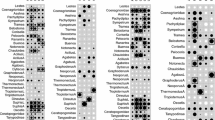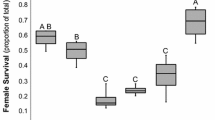Abstract
We identified, staged and counted the immature stages of mosquitoes from 1,826 censuses (with replacement) of the aquatic contents of ten treeholes surveyed every 2 weeks between 1978 and 1993. These time series were used to examine the population dynamics and effect on prey of the predatory mosquito Toxorhynchites rutilus. The mean annual frequency of occurrence of T. rutilus ranged from 0.02 to 0.67 among holes, and no fourth instars were recovered during a 30-month dry period. Oviposition and pupation by this species were recorded in all months, but most commonly in the spring. Overwintering larvae of the predator increased in weight during the prolonged fourth instar that preceded pupation in the spring. Time series analyses showed that the presence of a fourth instar T. rutilus significantly reduced the abundances of late-stage Aedes triseriatus mosquitoes. Pupal numbers of this prey species were more negatively affected by T. rutilus than were numbers of fourth instar A. triseriatus. Long-term declines in mean annual abundance of A. triseriatus prey during 16 years of observations on two holes were not correlated with increases in the mean annual frequencies of T. rutilus. Local extinctions of the aquatic stages of A. triseriatus within treeholes were common, but in most holes not significantly associated with the presence of T. rutilus, suggesting that predation does not routinely drive mosquito prey locally extinct in this ecosystem. The decoupling of T. rutilus and A. triseriatus, as revealed through these complete and long-term censuses, is contrasted with other reports of generalist predators causing extinctions of mosquito prey. Discrepancies among reported outcomes probably result from differences in duration of sampling periods and statistical procedures along with real differences in the intensity of predation among systems and sites.
Similar content being viewed by others
Author information
Authors and Affiliations
Additional information
Received: 14 August 1996 / Accepted: 24 February 1997
Rights and permissions
About this article
Cite this article
Lounibos, L., Escher, R., Nishimura, N. et al. Long-term dynamics of a predator used for biological control and decoupling from mosquito prey in a subtropical treehole ecosystem. Oecologia 111, 189–200 (1997). https://doi.org/10.1007/s004420050225
Issue Date:
DOI: https://doi.org/10.1007/s004420050225




